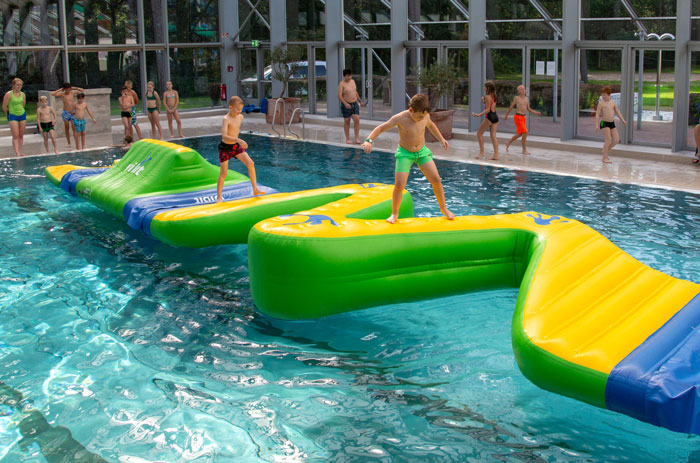Creating diverse aquatic programs for public pools is great for generating revenue and civic pride, but along with that comes the need to add a variety of equipment to the deck or water to support the overall user experience. From enhancing accessibility and recreational value to enabling competitive events, instructional programming and more, attention to the pool deck and equipment can make your aquatic facility successful.
Having a recreational/leisure pool that can host competitive events will elevate your pool’s offerings and provide opportunities for diverse programming that will boost revenue, said Darren Bevard, president and chief operating officer of Counsilman-Hunsaker. “The less ‘still water’ and the more programming options there are, the better for your bottom line. There is a broad range of facility types, and each one will have different design considerations. If you look at designing a deck space for an outdoor leisure pool in comparison to an indoor competition pool or hospitality facility, there are going to be different requirements. Some general considerations that are most important when designing deck space around a commercial swimming pool include the dimensions of the space itself. How much space can be provided?”
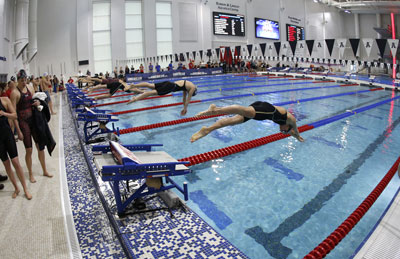
The more deck space you can provide for patrons to use and navigate nearby and adjacent to the swimming pool, the better off you are going to be, Bevard advised. You also must be mindful of any code requirements for deck spacing, which vary by jurisdiction and by facility type.
Agreeing with Bevard is Lisa Adams, marketing director for a Missoula, Mont.-based provider of aquatic equipment. “Having a leisure pool that can host competitive events will elevate your pool’s offerings and provide opportunities for diverse programing.”
Consider the design of an indoor competition pool, which is generally a rectangular linear pool. There are four different deck areas or quadrants, and the design or spacing of those deck spaces will be dictated by factors such as spectator sight lines and staging areas for athletes. The starting end of the pool will feature starting blocks, and the necessary deck width will be determined by the need for space for athletes in that area, including enough space to stage multiple athletes per lane for a relay event.
“From a spectator perspective, sight lines are essential to the spectator experience,” Bevard said. “If you have elevated seating, you need to ensure that the deck widths are not restricting sight lines of the first lane of the pool. Traffic patterns should be analyzed as well—people walking on the deck, traversing the deck. For a competition pool, officials, judges and coaches need to be on and navigate that deck. There is often a separation of officials from athletes or spectators if they are moving along a portion of the deck, to access different areas of the facility. That all has to be considered.
“Sometimes barriers come into play,” Bevard added: “You might have a system of railings or barricades to help direct traffic. Think about the space on the deck, the width of the deck, how people are going to navigate the deck and the traffic patterns.”
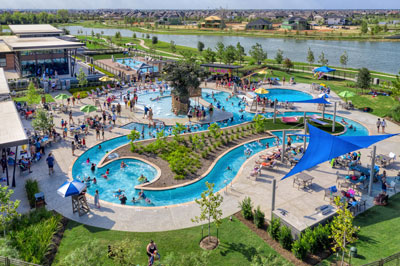
An outdoor family aquatic center might feature multiple bodies of water and different types of features and amenities. Look at the deck space from that perspective as well. If you have a waterslide in one location and you know that people are going to be cycling from the plunge pool back to the waterslide tower, the deck layout should prevent bottlenecks, where the flow of people on the deck crosses. Thinking about how people are going to move through the facility and setting up the deck space to accommodate that is important.
The placement of furnishings also comes into play here. Within the pool deck layout, you might see a waterslide, seating areas, lounge chairs, shade structures and picnic tables.
“Everything needs to be laid out in a thoughtful way from a design standpoint, to ensure that there is an effective use of the space and that it is not creating challenges from an operational perspective,” Bevard suggested.
Consider also the movement of your staff. The deck space adjacent to the pool has to allow for appropriate lifeguard placement and lifeguard sight lines, especially when you are starting to work in amenities. “You might have a unique freeform pool layout that has specific sightline requirements for lifeguarding safety purposes,” Bevard said. “There must be an area of the deck to place a lifeguard stand to effectively guard the facility.”
The finishes that are used on the deck are critical from an aesthetic perspective and important for the character of the facility. Slip resistance is absolutely critical as is deck drainage.
“We have done some elaborate design coordination of decks: color variation, jointing patterns to the point where some areas are sand-blasted or broom-finished, color concrete. All those things can enhance the aesthetic of the deck and a more complete facility design,” Bevard said.
Well-Equipped & Functional
When it comes to facility improvements, it’s not just obtaining the equipment that makes the difference, said Marley Cunningham, marketing director for a Missoula, Mont.-based provider of aquatic equipment. “It’s taking the time to choose quality equipment from reputable companies. A product range should provide solutions for aquatic access, recreation and therapeutic exercise.”
“There are a multitude of benefits involved in adding commercial-grade furniture and shade around a pool deck,” said Meagan Deacon, marketing director for a Lexington, Va., company that specializes in commercial outdoor furniture and amenities.
Comfort is key. “Chaise lounges can be added around the pool’s edge for sunbathing or relaxation, and while there are no specific ADA guidelines for chaise lounges, there are several with a higher seat height to accommodate those looking to make their area more accessible.”
Furniture is an important part of design. You’ll need to understand where to place furniture, setting up deck space and adjacencies so that it doesn’t create restrictions in movement. The furniture itself needs to be comfortable, durable and weather-resistant for outdoor installations.
Facilities that are emulating a resort-style mentality for patron comfort require higher-end furniture selections, with cushioned seating as opposed to hard surfaces. The appearance of the furniture can go a long way toward enhancing the experience and aesthetic of the facility.
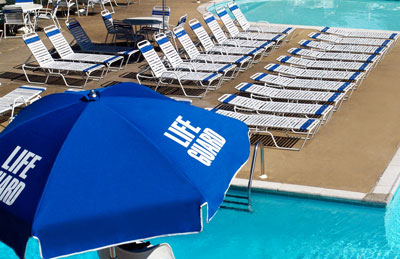
“Shade is a universal comfort in any outdoor setting,” Deacon continued. “There are multiple options for shade around a pool deck—market umbrellas, cabanas, four-post shade structures or cantilever umbrellas. It is important to make sure the shade structures used are commercial-grade.”
You’ll also need to think about the maintenance and durability of all those comfort features. Some shade structures use a fabric canopy, and some canopies are rated for snow load or wind load. Many have to be taken down when there is a storm event. From an operational perspective, that means ensuring you select a canopy that is simple to remove and replace.
Cabanas are a trend, Bevard said. “We are doing many cabanas at the municipal level and certainly at commercial waterparks. These are rental spaces, and the cabana design can take on various forms. You can rent a cabana for your family for a day, and the cabana has seating and dedicated refrigeration. It might have a sink, even a TV. At high-end resorts, these kinds of cabanas are incorporated into the poolside design.
“Shade is critical,” he added. “The more shade the better, but you have to think about placement in the space relative to the water area. It is even common now to shade some of the water areas as well, especially the shallow area where you have young children.”
S I D E B A R
Cover Story
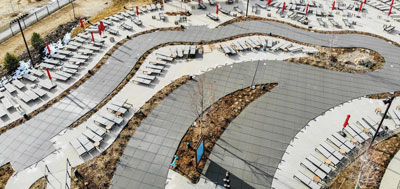
Covering your swimming pool is one of the very few opportunities you have to reduce your energy costs, stop destructive chloramines and lower your pool’s carbon footprint, said Lisa Adams, marketing manager for a manufacturer in Missoula, Mont.
“By investing and regularly using a pool cover, you actively participate in preserving our shared environment, reducing harmful chloramines and the carbon footprint of your pool, saving you thousands of dollars annually,” Adams explained.
Swimming pools lose energy in various ways, Adams said. Evaporating water depletes tremendous amounts of energy. It only takes one btu to raise one pound of water 1 degree Fahrenheit, but each pound of 80-degree water that evaporates takes a whopping 1,048 btu of heat out of the pool. Approximately 70% of energy loss is through evaporation.
Other benefits to covering a swimming pool include:
- Reduced chemical consumption.
- Makeup water will be reduced by 30% to 50%.
- If indoors, the building’s interior will experience less wear and tear. Fixtures, windowsills, paint, beams and exposed metals will all last longer in a less corrosive environment.
- Heating bills will be lower, and HVAC equipment will experience less strain.
“Most of the industry offers two pool cover materials, mesh and solid,” said Philip Saltzman, sales manager for a Melville, N.Y.-based pool cover manufacturer. “Some companies will offer an advanced-grade mesh. The advanced grade mesh is a tighter weave mesh. It filters a little more efficiently, keeps out finer sediments.
“Standard mesh covers,” Saltzman explained, “are made with a polypropylene mesh material. It will block 99% of sunlight from reaching the pool water, prevent photosynthesis and will potentially eliminate algae growth. That’s why the rugged mesh has become so popular in the past decade.”
They are easier to handle due to their lighter weight. They also cost less than a solid vinyl pool cover.
Different materials can be deployed for different size requirements. “We have made covers in excess of 10,000 square feet in this polypropylene material,” Saltzman said.
In the case of a lazy river his company provided a cover for, Saltzman said the cover had to be made in seven sections, for a total of 50,000 square feet.
Be aware that some covers are made for daily use during the swim season, while others are specifically designed to protect your pool over the winter
season.
Compete With the Best
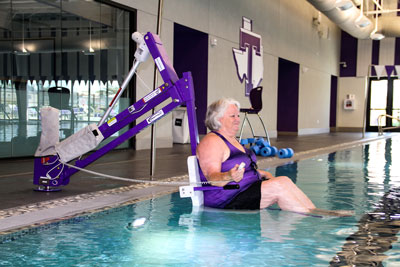
Hosting competitions is one way to increase revenue for aquatic facilities, said Cunningham. “The choice of equipment at competition pools is very important, not only for functionality from an athlete’s perspective, but also the user experience for spectators.”
Scoreboards, for example, have evolved. “Decades ago, an aquatic competition scoreboard had a very simple numeric display,” Bevard said. “Now, everything is across-the-board full video display, where the scoreboard gets all access to all the data related to the competition. The latest scoreboards also do graphics, video and advertisements, and can be used for other types of events, such as doing a movie-viewing in the pool or a promotional video playing during certain events. Scoreboards have evolved to the point where many facilities are utilizing the full video display capabilities for the scoreboards themselves. That has been a trend that is now an industry standard.”
If the pool adheres to the necessary length and depth specifications, incorporating starting blocks for competitive swimming, along with diving and water polo equipment, broadens the facility’s capabilities to serve as a
rental space for teams to conduct practices and host official meets.
There are two types of swimming starting blocks, Adams explained: competitive and non-competitive. Choosing the right one comes down to how you plan to use it. A competitive block is the way to go if you plan to host official meets. On the other hand, if you have a practice facility or don’t need to meet the more stringent requirements for official competition, a non-competitive block is a more cost-efficient option.
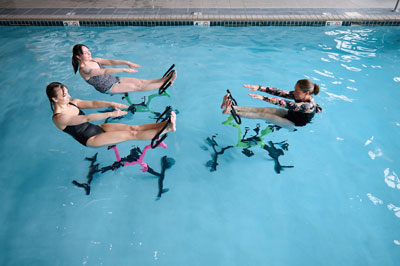
For specific competitions, lane lines are necessary and important from the standpoint of maintaining ideal competition conditions for athletes, Bevard noted. Floating lane lines continue to evolve, with different sizes, as well as designs that quell the waves created by competitive swimmers.
When it comes to competitive equipment, coaches’ and athletes’ preferences should be considered when going through program confirmation and equipment selection for the facility, Bevard said. Ask stakeholders to help identify the appropriate platform based on preference and level of competition.
For water polo equipment, there are certain dimensional requirements for the field of play. As far as the equipment, floating goals are always desired if there is enough space to use them. There are different types of floating goals. Some fold for storage, some do not. The way they are tethered in the pool can also differ, depending on the manufacturer.
From a design perspective, different color and branding options such as custom logos and even advertising and co-sponsorship options are available on the starting platform. It’s rare in this day and age to see a high-end competitive venue that doesn’t have some form of branding, for example with a university’s logo and colors.
Have Fun!
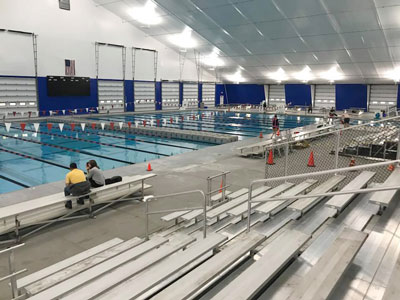
Research and understand the needs of your community to select equipment that serves their needs and interests. “Take the necessary steps to ensure you are making a good investment that will be more likely to bring you a return,” Adams said. “Facilities located in communities with an older demographic profile will need to focus on access and therapy solutions, while facilities located in communities with young families and lots of children might want to consider a [poolside climbing wall].”
Adding recreation equipment to your pool will boost revenue by creating excitement and grabbing the attention of pool-goers. “The more you can offer, the better,” Adams added. “The best bang for your buck is pool climbing walls. A climbing wall can be assembled in a few hours and provide hours of fun.
“Smaller budget facilities need to find strategic and modest investments to inject new excitement into a pool. Pool climbing walls do just that. They bring about a significant transformation with minimal financial investment. For example, Chimney Park Pool in Windsor, Colo., reported a 30% increase in revenue since having a climbing wall installed.”
Poolside basketball hoops are also available for a minimal investment.
For those facilities with a larger budget, slides will always be an attention-grabbing feature. Year after year, slides rank as the most desired pool amenity. Adam’s organization offers two types of slides: “Our traditional waterslides offer an exhilarating investment that guarantees a surge of interest in your pool, increasing revenue. Poolside slides present a cost-effective option for those seeking thrilling twists and turns without the need for water propulsion, making them a more budget-friendly choice.
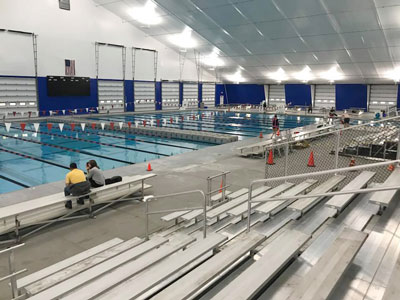
Facilities that provide a great deal of open water, especially competition pools that are primarily used for lap swim and competition, will want a way to enhance their program capabilities and bring in patrons for recreational use. Inflatables are a good way to do that. They can be put in the pool for a portion of the day, or a certain day of the week, thus opening up the facility for other types of uses. There can even be a competition using these floating obstacle courses. “We do a lot of that in our facilities in terms of enhancing open water areas,” Bevard said.
There are also other types of floating apparatuses, such as a lily pad walk.
As for waterslides, “There are a million different types and styles,” Bevard said, “everything from a little toddler slide to a flagship waterslide feature that can have more of the extreme or adventure type value from a user perspective. From a design consideration it is about what is desired for the facility: what age groups, what type demographic are you trying to serve with these features, what the budget will allow and then what you have space for within the facility.”
The wide variety of slides includes everything from body flume slides to raft rides, mat racers and more. “As designers,” Bevard noted, “we collaborate with the slide manufacturers on our projects, and we show examples from other facilities from past designs to get an understanding of what the stakeholder’s desire and appetites are for those types of things. There are enhancements to these rides that are now available, such as sliding effects or sound effects. In some cases you can do visual effects, such as at the top of the slide tower there is a touch screen where you can select your theme for the ride such as an underwater theme or a jungle theme that will change the lighting and sounding effects and in some cases a motion picture effect. A user might be sliding down an enclosed flume, and you come around a corner and it’s as if you are sliding into a shark’s mouth. You can create some real excitement.”
Instruction & Fitness
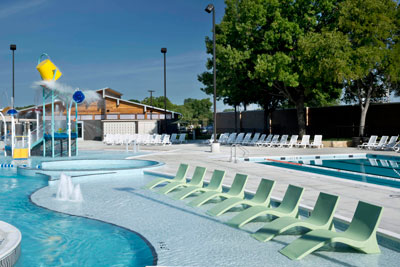
Swim platforms and underwater exercise equipment offerings have greatly increased programming possibilities. Various manufacturers offer a wide variety of equipment, such as underwater treadmills or stationary bicycles that can be deployed in the pool and utilized for spin classes.
There are all different types of basic fitness equipment, Adams said, such as flotation devices, or weight belts, but as far as exercise equipment goes, underwater treadmills are fairly popular. You have to understand the intent and specify the right equipment.
Dedicated therapy pools use warmer water temperatures and deploy equipment for athlete rehabilitation, injury recovery and physical therapy—even general mobility and arthritis treatment. “Some dedicated therapy pools,” Bevard said, “are designed with the underwater apparatus like treadmills already incorporated permanently into the pool floor. Or maybe it is a moveable floor so that we can adjust water depth for different patrons and different types of activity.”
Inclusion & Accessibility
“Embracing universal design in aquatic facilities is more than a commitment to accessibility—it’s a strategic investment,” Cunningham said. “By making your space inclusive for all, you not only future-proof your facility, but also unlock greater potential for return by welcoming a broader range of users.”
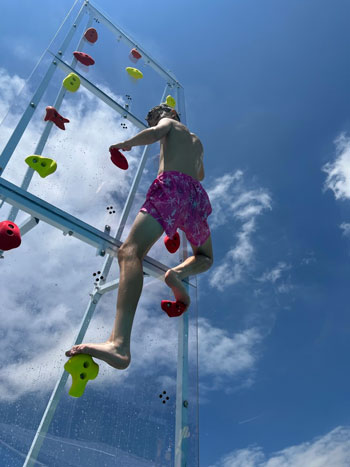
In 2002, Cunningham said, “our founder saw a need for a major evolution in pool lifts, which at the time were very institutional and didn’t feel welcoming to the people who needed to use them. He started a company with the goal not only to simply provide better pool access, but also to improve the lives of the many people who seek aquatic therapy to improve their quality of life. For many of those people—those with disabilities, mobility impairments or chronic illnesses—the water is the only place that they can experience pain-free movement.”
Being inclusive is crucial to providing comfort for those with mobility issues at your facility, Adams said. Pool deck equipment, such as ADA-compliant pool lifts, stair and handrails, transfer rails, ladders and access ramps, plays a crucial role in a swimming pool’s functionality, while being comfortable and inclusive to those who need it.
Facilities nationwide have embraced the installation of ADA-compliant pool lifts to ensure equal access to their aquatic facilities, Adams said. Whether you prefer battery-powered or water-powered pool chair lifts, there are a range of lifts suitable for any setting.
Guidelines set according to the ADA dictate what is required from a minimum standpoint for access to the pool. Every public pool is required to have at least one primary ADA-compliant access, maybe a lift or a compliant sloped entry. A pool lift is the most common form of access provided, but other means of access are available, including sloped entries and transfer systems. RM



